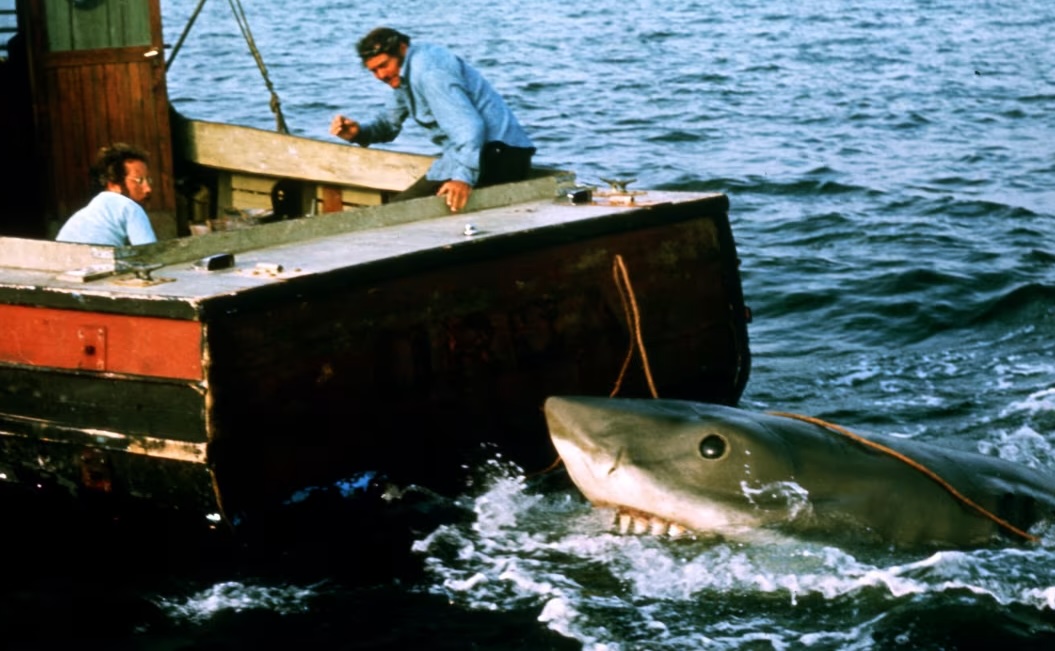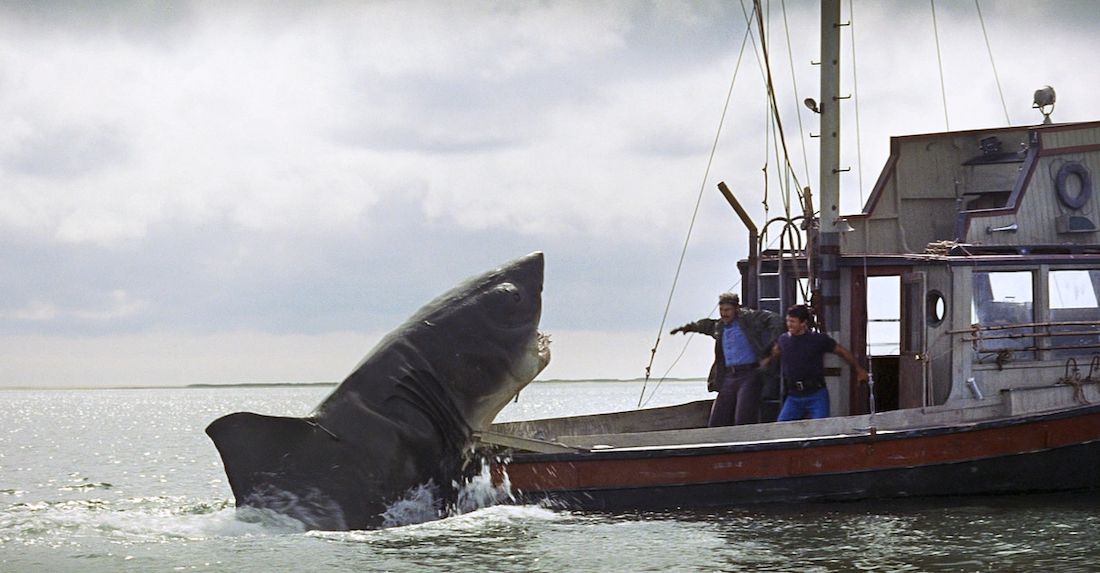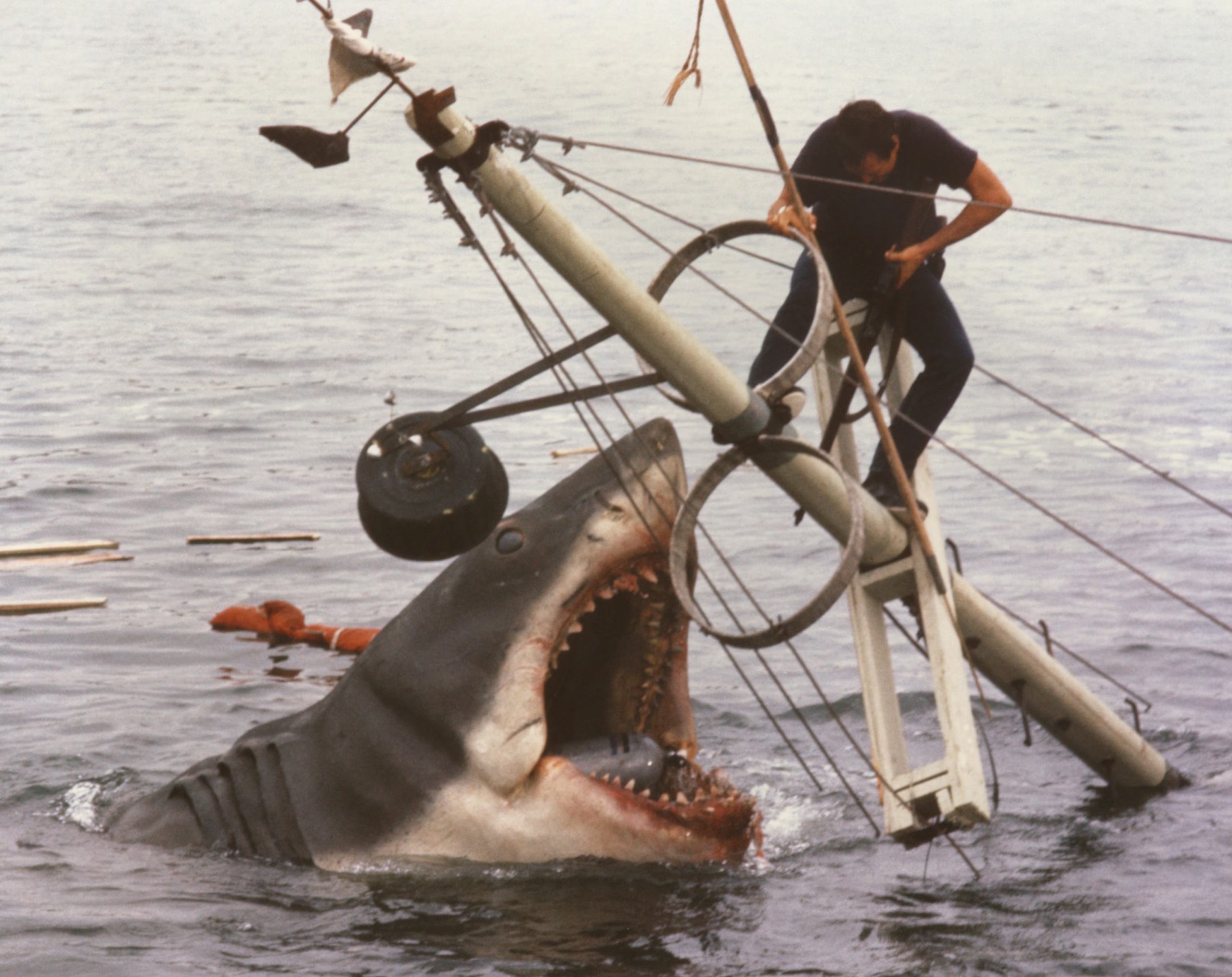The Undeniable Greatness of Jaws
Jaws is rightly celebrated as a landmark, generation-defining hit. But it’s not sufficiently recognized as a great 1970s film, exemplifying that rocky decade’s political ire, acerbic social critique, and the lingering practices of realist cinema movements.

Jaws is a real 1970s film, made when the angry, assertive social justice politics of the era still infused the culture and the movies. (Universal)
There are a number of striking revelations in the documentary Jaws @ 50: The Definitive Inside Story that’s currently on Hulu in honor of the fiftieth anniversary of the release of Jaws, Steven Spielberg’s masterpiece of oceangoing terror. But the most delightful is that Fidel Castro read the source material, Peter Benchley’s same-named bestselling novel, and made this appreciative comment: “It’s a marvelous metaphor for the corruption of capitalism.”
For many years, leftists on social media have viewed the movie in this light, especially by expressing their affection for Murray Hamilton’s performance as the smarmy and ruthless mayor of Amity, the Massachusetts tourist town where a monstrous great white shark feeding on local swimmers threatens to ruin the summer tourist trade. The character of Mayor Larry Vaughn is applicable to so many situations in the United States. Every time another governmental authority figure sacrifices the well-being of citizens for the sake of the “bigger financial picture,” which is every day of our lives, we can trot out Murray Hamilton as the mayor for quick satirical commentary on the perverse earthly hell we’re burning in.
“Those beaches will be open on Fourth of July,” the mayor orders the beleaguered police chief Martin Brody (Roy Scheider), overriding any concern for human welfare. And indeed, the beaches are open and crowded, but the beachgoers are afraid to take a dip in the water, so the mayor personally starts herding them in lest the photo ops look odd and the tourist dollars stop flowing. “Remember, as you know, Amity means friendship,” he says reassuringly to a TV reporter, grinning his empty-eyed politician’s grin.
That’s the shark we know, the human-shark, one of the many that dominate American life. The shark we don’t know — or didn’t, in 1975 — is Spielberg’s “perfect eating machine,” the rarely glimpsed great white that fills us with atavistic terror. But we get its underwater shark’s-eye view of all that vulnerable human flesh kicking and splashing near the surface as John Williams’s ominous two-note theme sounds the warning of imminent bloody attack.

Jaws is a real 1970s film, made when the angry, assertive social justice politics of the era still infused the culture and the movies. “It was the turbulent time of the Vietnam War and Watergate,” as Spielberg noted of the backdrop to making Jaws. The “New Hollywood” cinema of the 1960s to ’70s was influenced by European art films movements like Italian neorealism and the French New Wave, the radical cinema of liberation known as Third Cinema — centered in Latin American countries but meant to represent a three-continent struggle for postcolonial freedom in Latin America, Africa, and Asia — and the underground and experimental cinema flourishing in the United States as well as internationally. The combined strength of those influences had their effect on mainstream commercial films of that era, which were often surprisingly daring in both content and style. Young filmmakers who had strong political views were given unprecedented access to studio projects because, at a time when the old studio system was on its last legs, hiring them was a desperate final gambit to hang onto “the youth audience.”
So Spielberg, George Lucas, Martin Scorsese, Francis Ford Coppola, Hal Ashby, Michael Cimino, and many other directors were given a remarkably free hand and a shot at auteur status. Though Spielberg was terrified that he was going to be fired as the Jaws shoot ran way over schedule and over budget — mainly because the mechanical shark didn’t work and “everything shot on water takes twice as long” — he wasn’t. He was given tremendous creative leeway. The script was being rewritten during production, as Spielberg collaborated with additional screenwriters on the script generated by Peter Benchley and Carl Gottlieb and incorporated the input of the three lead actors, who were improvising dialogue and bits of business generated among themselves in a competitive fury behind the scenes.
For example, Robert Shaw as Quint, the hardcase captain of the Orca, ad-libbed the bit when he finishes his beer and crushes the can with one hand, which was mockingly answered by Richard Dreyfuss as wealthy, academically trained oceanographer Hooper finishing his coffee and crushing the Styrofoam cup with one hand.

The legendary fact-based USS Indianapolis monologue delivered by Shaw as Quint was another last-minute inspiration, with screenwriter Howard Sackler suggesting that Quint needed a motive for his vengeful pursuit of the great white. John Milius then wrote a seven- or eight-page monologue, and Shaw took it home to edit it down to the much more compact version he delivers in the film. It’s the harrowing tale of Quint’s experience as a USS Indianapolis seaman after the ship delivered parts of the atom bomb to be dropped on Hiroshima and was subsequently sunk by Japanese torpedoes. Eleven hundred men went into the water, but only 316 survived the sharks’ feeding frenzy that followed.
It’s impossible to forget some of the ghastly details of that speech: The revelation that the bomb-delivering mission was so top secret, no distress signal was ever sent to save the men. The friend of Quint’s who’s clinging onto floating refuse and seems to be sleeping but, when touched, bobs up and down weightlessly in the water because a shark has bitten his body in half. The eyes of a shark seen up close by Quint, who describes them as “lifeless eyes. Black eyes. Like a doll’s eyes.”
And that final bleak and sardonic line of Quint’s, said with Shaw’s disturbing grin: “Anyway, we delivered the bomb.”
It’s clear that the enormous difficulties of making Jaws pushed young Spielberg beyond his limits as a filmmaker, as he himself attests in Jaws @ 50, saying he had belated panic attacks about the film even after it premiered and became such a record-breaking success. It was the main film hit of the 1970s, besides The Godfather, The Exorcist, and Star Wars, to dictate the terms of a new blockbuster-based, relentlessly commercial business model in Hollywood that ended a decade of New Hollywood auteur-based experimentation. These changes in the business operations of the American film industry are strangely omitted in the documentary.
For years afterward, Spielberg woke up in a cold sweat from nightmares about still being in production on Jaws. He found relief from lingering filmmaker PTSD by periodically going after hours to the Orca set, preserved at Universal Studios, to weep while sitting in the leatherette booth where Quint told the USS Indianapolis story, “the thing I’m proudest of in Jaws.”
The formal power of the film represents Spielberg at his zenith. His deployment of the dolly zoom, an extreme and rarely used Alfred Hitchcock camera technique invented for Vertigo, to convey Brody’s horror when the Kintner boy is attacked by the great white, is beyond all praise. But even subtler shots are wonderful, like the threatening dominance of the ocean in widescreen shots of the water-phobic Brody early in the film. Working with Verna Fields, Spielberg’s cut of the film moves with extraordinary rhythmic feeling and precision. It’s almost impossible to watch any sequence in Jaws without becoming engrossed again, no matter how many times you’ve seen it.
Attesting to its brilliance are many directors interviewed in Jaws @ 50, including Jordan Peele, Guillermo del Toro, George Lucas, Cameron Crowe, Emily Blunt, Robert Zemeckis, and James Cameron. Steven Soderbergh is shown wearing his vintage fanboy Jaws T-shirt, claiming to have seen the film thirty-one times in the theater, and saying that Jaws inspired him to consider becoming a director himself.
The stylistic greatness of Jaws earned him the spot-on tribute from Pauline Kael in her review, noting that, at last, film had thrown off the last vestiges of its entertainment predecessor, the theater. While so many other directors remained strangely stage-bound in their imaginations, Spielberg created immersive three-dimensional shots such as those amid panicked beach crowds. They indicated, as Kael quotes an unnamed “older director” saying, “He must never have seen a play; he’s the first one of us who doesn’t think in terms of the proscenium arch. With him, there’s nothing but the camera lens.”
In Spielberg’s struggle with the arduous pressures of production, he worked more inventively and arrived at more rough-hewn and startling filmic effects than he ever would again. And that 1970s political climate played a big part in giving Jaws its unusual edginess, which disappeared from his subsequent movies, no matter how successful, slickly realized, and highly praised. What other Spielberg film would ever draw the majority of its cast from the local citizenry? Jaws is practically a neorealist throwback in its location setting and use of nonprofessional actors, with only eight lead actors brought from Hollywood while all the other performers were drawn from the small Martha’s Vineyard population.
Interviewed in Jaws @ 50, Jeffrey Voorhees, the boy who played doomed Alex Kintner, said he wasn’t spooked by playing a shark attack victim because he was more afraid of “freezing my twelve-year-old ass off” in the frigid Atlantic waters in May, when the shoot began. And Jonathan Filley, the young man whose fireside flirtation with a young woman led to the run down the beach to go night-swimming that provided the great white with its first victim, attested to the way Spielberg accepted the input of even minor local actors appearing in Jaws. Filley objected to the bell-bottomed pants and other excessively hippie-eish garments he was being asked to wear as a costume and was allowed to wear his own ordinary khaki pants and pale blue Oxford shirt instead.
Spielberg was a made man at age twenty-nine, after his two films of raw stripped-down desperation, Duel (1971) and Jaws, which gave him cause for worry that he might get typed forever as the “truck and shark guy.” But after the 1980s, Spielberg was ever more a man of the Reagan era. An incredibly gifted and facile director, he tended toward comparatively safe-playing entertainments with less and less leakage in them representing the turmoil of the times. His mirroring of the dominant culture even as it shifted radically is one reason why Steven Spielberg is still a top hitmaking director fifty years later. And that’s definitely not covered in the documentary.
Jaws is rightly celebrated as a landmark, generation-defining hit that launched the career of the preeminent popular director of the American film industry and continues to thrill viewers with its propulsive narrative and formal dynamism. But it’s not sufficiently recognized as a great 1970s film, exemplifying that rocky decade’s political ire, acerbic social critique, and the lingering collaborative practices of realist cinema movements that have largely died out of mainstream filmmaking since then.